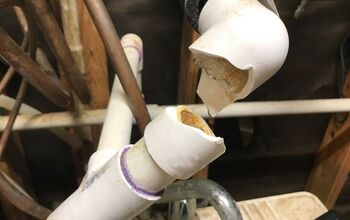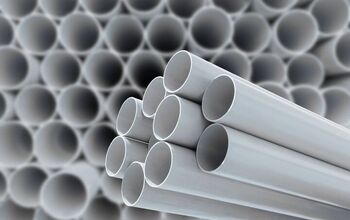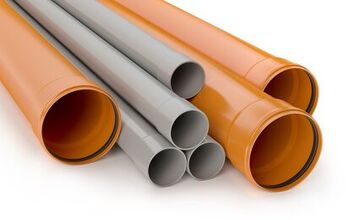What Is Gray PVC Pipe Used For? (Find Out Now!)

You are planning a small project at your house that requires PVC pipe to re-route some plumbing. At the home improvement store, you find a variety of sizes of PVC. Some of the PVC pipe is white, and some are gray. You are familiar with white PVC pipe but wonder what is the gray PVC pipe used for?
PVC pipe comes in several colors. Gray is most often associated with two types of PVC pipe. Schedule 80 PVC pipe is tinted a light gray. Electrical conduit is tinted a dark gray. Schedule 80 PVC has thicker walls and can withstand higher pressures. PVC conduit is made to easily pull wire through and has thinner walls than other PVC.
PVC Conduit typically doesn’t have a pressure rating since it does not carry fluids. Schedule 80 PVC is usually used in applications with higher than normal pressure requirements. In general, PVC conduit is not suitable for potable water applications. You should understand the differences between these types of PVC pipe before starting your project
Do You Need a Faucet, Fixture, or Pipe Repair or Replacement?
Get free, zero-commitment quotes from pro contractors near you.

What is PVC?
PVC, or polyvinyl chloride, is a plastic material with hundreds of uses. Most people are well acquainted with PVC pipe. This easy-to-use and economical type of pipe are used widely in residential and commercial construction.
PVC pipe comes in a variety of styles, sizes, and colors. Each style and size has characteristics suitable for different job applications. In some cases, local building codes require different PVC pipe colors to indicate the pipe’s function. For example:
- White PVC pipe – White PVC pipe is typically used for potable water systems and irrigation installations.
- Blue PVC Pipe – In some jurisdictions, a system that carries potable water must use blue PVC pipe. This is especially true in large water distribution systems such as water mains and pump stations.
- Green PVC Pipe – Green PVC pipe indicates that the system carries wastewater or sewage. This standard is mostly applied to municipal wastewater treatment systems where large diameter waste pipes are built underground.
- Purple PVC Pipe – Many new homes feature split waste systems. In these split systems, black water is separated from gray water. The black water goes to the main sewer line or the septic system. Gray water can be reclaimed and reused under some circumstances. Gray wastewater piping is indicated by a purple PVC pipe.
- Gray PVC Pipe – A gray color PVC pipe can indicate two different styles of PVC. If the pipe is tinted a light gray, it is usually schedule 80 PVC and is where the system experiences higher pressure. A dark-gray colored PVC pipe is more than likely an electrical conduit and should not be used for plumbing.
Confusion may come when considering gray PVC pipe. Schedule 80- gray PVC pipe is suitable for all applications where white PVC pipe can be used. The thicker walls of schedule 80 PVC will withstand higher pressure. Gray conduit PVC has thin walls and is not rated for pressure or potable water applications.
The Other Differences in Gray PVC
Schedule 80 and electrical conduit may look very similar but have significant differences. These differences make these two different types of PVC pipe incompatible. Therefore, the two should not be mixed. The major ways the two types of PVC pipe differ include the following.
Wall Thickness and Pressure Ratings
Schedule 80 PVC pipe has thicker walls than other PVC pipe. The thicker walls allow schedule 80 PVC pipe to withstand higher working pressures. On the other hand, gray PVC electrical conduit has much thinner walls. Electrical conduit is not meant to be put under pressure or to carry water or other liquids.
Electrical Conduit made of PVC does not carry a pressure rating stamped on the pipe. Schedule 80 PVC will have labeling that indicates the pipe’s pressure rating.
Coupling Designs
The couplings designed for each type of gray PVC have different looks and are meant for different purposes. For example:
- Schedule 80 couplings will be gray like schedule 80 pipe. The couplings have the same wall thickness and carry the same pressure rating.
- Electrical conduit fittings made of PVC have no pressure rating. PVC electrical conduit is not rated for potable water use and should never be installed in a residential or commercial water distribution system.
- The fittings made for electrical conduit PVC are different. Electrical conduit fittings feature long sweepings turns and connections that allow the electrical wire to easily pull through the conduit. Schedule 80 and other PVC connectors feature shorter radius turns at the corners because they are designed to carry fluids, not wire.
The two types of gray PVC pipes are designed for specific functions that are not compatible. You should not plumb water supply systems with gray PVC electrical conduit.
Do I Need Special Glue for Gray PVC?
PVC is PVC. The same glue you use to make the joints for your irrigation system will work fine with the electrical conduit you install for your patio lighting. There are different requirements when cementing joints on a pressurized water system rather than on an electrical conduit.
Any PVC pipe that carries liquids, especially under pressure, must make tight and secure cement joints. Typically, making secure solvent cement joints is a four-step process.
Step 1: Cut, Clean, and Deburr
The pipe should be cut to the appropriate length allowing for the fitting. The cut should be smooth and clean. Keep the cut perpendicular to the pipe for a flush fit inside the fitting. Remove any burrs or tails from the cut edge if you use a saw. Wipe down the surfaces to be solvent cemented to remove any dust or debris.
Step 2: Apply primer to the Joints
The PVC primer is important to prepare the surface of the plastic pipe for the solvent that actually forms the joint. Use the applicator included with the can to apply the solvent to all surfaces that will be cemented. Let the primer dry for a few minutes before applying the solvent cement.
Step 3: Apply the Solvent Cement
Once the primer is dry, apply solvent cement to the primed areas of the pipe. Get an even coat of solvent cement on all the surfaces to be luted. Don’t go overboard. Drips and runs are not a good sign. You should only apply cement to one or two pieces of pipe and fittings at a time.
Step 4: Make the Joint
Slip the PVC pipe into the fitting and push until the end of the pipe seats firmly against the stop in the fitting. Give the pipe a one-quarter turn to ensure the solvent cement is evenly spread. Hold the joint tight for at least 30 seconds to give the cement time to begin to cure.
Do You Need a Faucet, Fixture, or Pipe Repair or Replacement?
Get free, zero-commitment quotes from pro contractors near you.

Gray PVC – One Color, Two Jobs
Schedule 80 gray PVC is used in high-pressure plumbing projects where white PVC may not meet the pressure specifications. Gray electrical PVC conduit should never be used in plumbing applications. It is designed to protect electrical wiring only.
Related Guide

Dennis is a retired firefighter with an extensive background in construction, home improvement, and remodeling. He worked in the trades part-time while serving as an active firefighter. On his retirement, he started a remodeling and home repair business, which he ran for several years.
More by Dennis Howard















![10 Most Dangerous Neighborhoods in Baltimore [Updated]](https://cdn-fastly.upgradedhome.com/media/2023/07/31/9075655/10-most-dangerous-neighborhoods-in-baltimore-updated.jpg?size=350x220)











